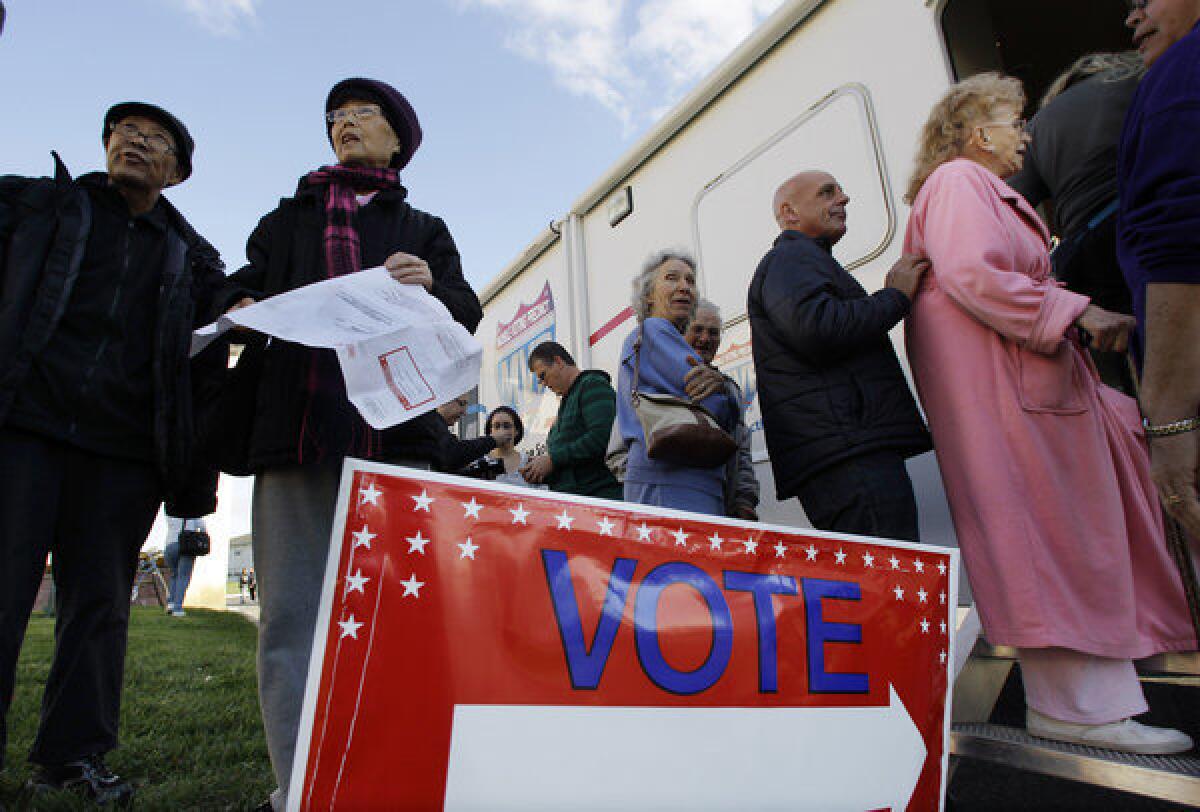Why do we vote?

- Share via
For those inclined to worry about the American civic fabric, election day offers plenty of opportunity. Even in our most high-stakes elections, barely half of those with the right to vote exercise it. The number drops dramatically when the presidency doesn’t hang in the balance. By nearly every measurement, the United States has among the lowest voter turnout rates of any industrialized country. Why, the worriers ask, do so few citizens vote?
But there’s another way to look at it. Today we will see some 130 million Americans, give or take a few, arrive at polling places knowing that they may have to stand in long lines, possibly for hours, to cast a vote for Barack Obama or Mitt Romney. And the vast majority will be doing this with the awareness that, because of the way the electoral college works, their choices will have no bearing on who takes the White House. So maybe the worriers are asking the wrong question. The bigger question is: Why do so many of us vote?
Starting in the 1960s, political scientists reduced this dynamic to long equations that assumed citizens approached election day weighing their options like economists. Would-be voters weighed the relative costs of voting (learning about the candidates, traveling to polling places, waiting in line) against the benefits (the chance that their votes would be pivotal in swinging an election in the direction that would afford them material benefits). When the benefits outweighed the costs, they headed to the polls.
ENDORSEMENTS: The Times’ recommendations for Nov. 6
In 1998, two Yale political scientists decided to challenge this logic. They set out on the streets of New Haven, Conn., with an experiment that would treat voters as their guinea pigs. Don Green and Alan Gerber launched a nonpartisan get-out-the-vote drive, and randomly assigned voters to receive preelection reminders either by postcard, phone call or a doorstep visit from a canvasser. If any of them had even a slight impact on increasing turnout, Green and Gerber thought, they would show that it was possible to influence a citizen’s likelihood of casting a ballot without altering the cost-benefit math that their colleagues thought sustained the decision to do so.
Green and Gerber found that the phone reminder had no effect, but the in-person visit from a canvasser delivered a significant one. In the following years, their randomized-control trials shifted from testing the effectiveness of different modes of get-out-the-vote reminders to more complex motivational techniques informed by behavioral psychology. Experimenters — many aligned with the Analyst Institute, a think-tank-cum-secret-society that conducts electoral experiments for the left’s top institutions, including the Obama campaign — discovered that it was possible to increase turnout simply by talking up voting as a popular activity or addressing reminders to “the type of person who votes.”
The most impressive result Green and Gerber ever found came when they reminded voters that whether or not they cast a ballot was a matter of public record — by mailing them a copy of their vote history, and those of their neighbors. This simple act increased turnout by 20% (though it also earned death threats to the direct-mail consultant who identified his company as the sender).
COMMENTARY AND ANALYSIS: Obama vs. Romney
In the last few days, this psychological technique has been repackaged by groups on the left and the right as both a threatening “audit” and encouraging “report card.” All make the same point: Voting is not a private act.
What is so remarkable about all these nudges for increasing voting is that they never mention the candidates, the issues, the stakes for the parties or consequences of policies of a particular election outcome. Indeed, in experiments, conventional political messaging regularly fails to have any effect on turnout. Information about how much the deficit has grown under President Obama or arguments about what’s wrong with Romney’s “47% thinking” may sway an undecided voter, but it is unlikely to push someone who is not a habitual voter to the polls.
The behavioralist revolution in campaigns has clarified the extent to which voting represents two distinct human commitments: deciding which candidate to support, and actually getting to the polls. The research has cleanly split campaign communication into two phases. Persuasion is about changing voters’ minds; mobilization is about modifying their behavior.
Harvard psychologist Todd Rogers, the founding executive director of the Analyst Institute, said many of these behavioral interventions succeed in increasing participation because they alter the social dynamics before, during and after voting. Small nudges, he has written, work best when they speak to a citizen’s “basic need for belonging.”
At its purest, that is a calculus about what drives people that has little room for what both campaign strategists and pundits call “enthusiasm.” Whether one votes for Obama or Romney is a binary choice, in which intensity of feeling is irrelevant. The decision whether to disrupt one’s usual Tuesday schedule to go to the polls appears to have much less to do with how we see the candidates than with how we want to see ourselves, and want others to see us. If enthusiasm pushes people to endure long lines in the cold or the heat Tuesday, it might not be because they are excited to join a political movement but merely because they aspire to be part of what their neighbors are doing.
Sasha Issenberg is a journalist and the author of “The Victory Lab: The Secret Science of Winning Campaigns.”
More to Read
A cure for the common opinion
Get thought-provoking perspectives with our weekly newsletter.
You may occasionally receive promotional content from the Los Angeles Times.










